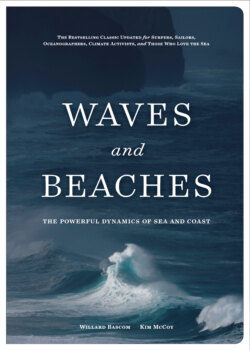Читать книгу Waves and Beaches - Kim McCoy - Страница 16
На сайте Литреса книга снята с продажи.
1Genesis of Land, Water, and Waves
ОглавлениеWaves are undulating forms of energy that can propagate through any medium—wave energy travels throughout the universe. Waves may exist in solids or on the interface between any two fluids of different densities, but this book will deal primarily with those that travel on the surface between the ocean and the atmosphere. Although any kind of disturbance in the water is likely to generate waves, there are three prime natural causes: wind, earthquakes, and the gravitational pulls of the Moon and the Sun.
Wind waves are the most familiar kind; they are also the most variable and, in many ways, the most puzzling. The size and variety of the waves raised by the wind depend on three main factors: the velocity of the wind, the distance it blows across the water, and the length of time it blows. Moreover, the character of the waves changes markedly as they move away from the winds that created them.
The earthquake mechanism for wave creation is simpler and thankfully less frequent. In this version, a rapid motion of the subsea rocks disturbs a mass of water. In regaining its equilibrium the water surface oscillates up and down and sends out a series of seismic sea waves, collectively called a tsunami (tsunami means “harbor wave” in Japanese from the characters tsu, meaning “harbor,” and nami, meaning “wave”).
The tides, which are a special kind of very long wave, are caused by the Earth’s turning beneath great bulges of water raised by the combined rotational forces and gravitational fields of the Moon and the Sun.
The wave of climate change is another very long wave; it traverses human generations yet affects the power and location of winds, the genesis of waves, and the swash of every beach. We have just begun to see and understand its profound influence on all other waves. It is the most important wave ever experienced by civilization and one that cannot be separated from any conversation about ocean dynamics.
Regardless of the mechanism by which a wave is generated, the character of waves and the velocity at which they move are influenced by the depth of the water in which they are traveling. Therefore, in order to understand the behavior of waves, one must also know something about the shapes of the rocky basins that hold the water. So, let’s first consider the beginnings of the water and the land—the origin of the Earth’s surface features.
